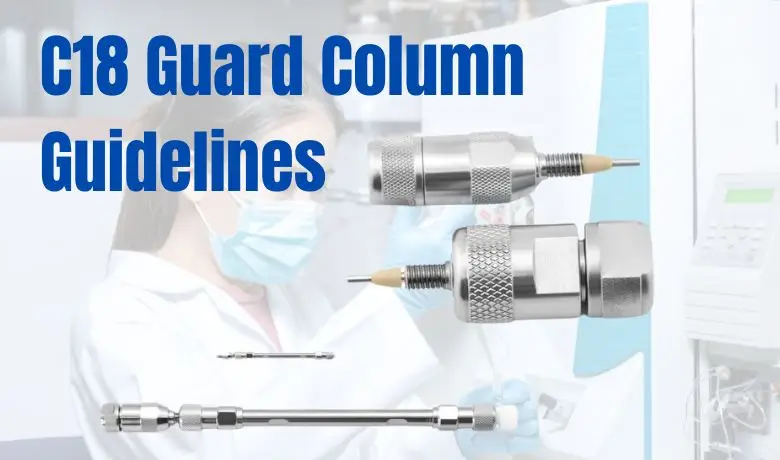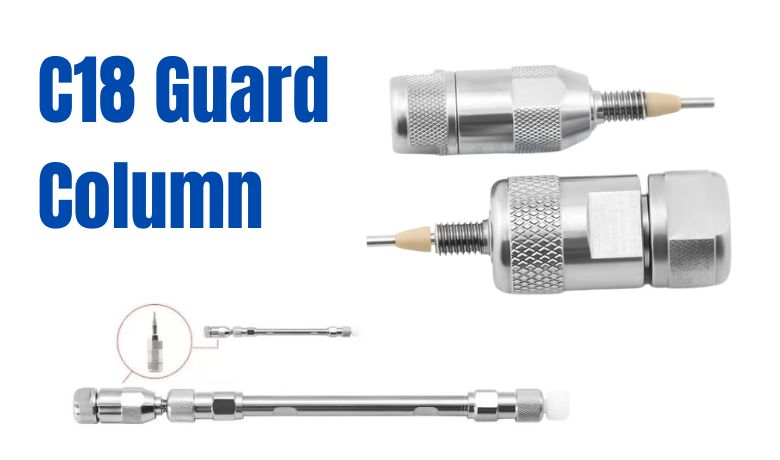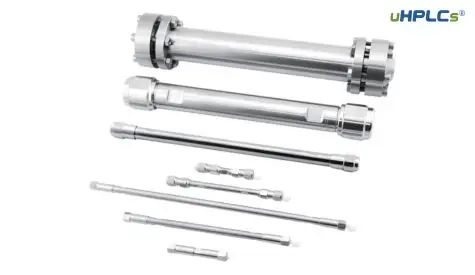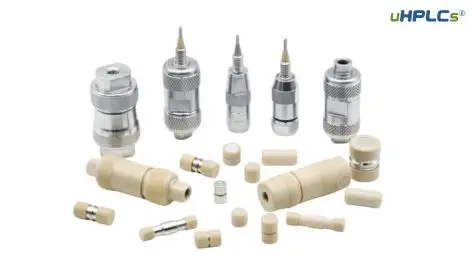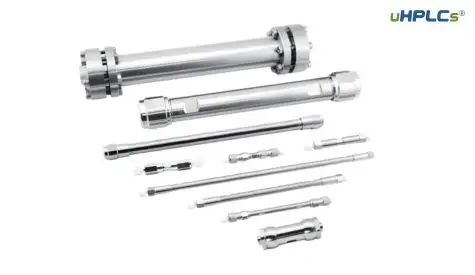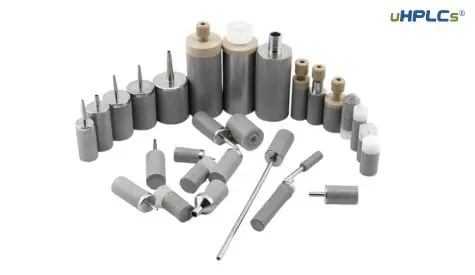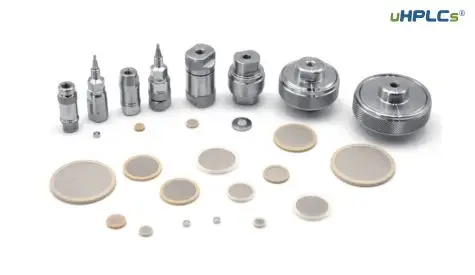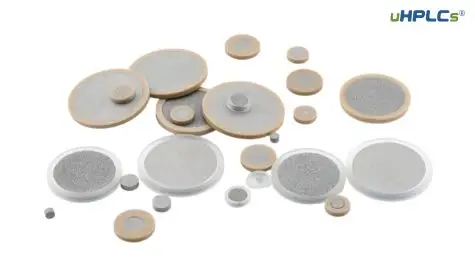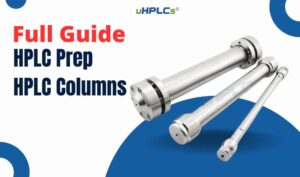A C18 guard column is a small disposable cartridge filled with the same packing material as your main analytical column, but typically shorter in length. C18 refers to a specific type of stationary phase used in high-performance liquid chromatography (HPLC).
For this Guidelines, will included as following information, hope will be helpful.
This blog will delve deeper into the world of C18 guard columns for HPLC. We’ll cover:
- Different types of C18 guard columns available
- How to choose the right guard column for your application
- The benefits of using guard columns in HPLC
- Tips for maintaining and replacing guard columns
Understanding C18 Guard Columns
What are C18 Guard Columns?
A C18 guard column is a small, disposable cartridge placed before your main analytical column in an HPLC system. It typically holds the same stationary phase material (packing material) as your main column, but in a shorter length. The C18 refers to the specific type of stationary phase used, which is chemically bonded with octadecyl (18-carbon chain) groups.
C18 vs. Other Guard Columns:
- Stationary Phase: C18 is the most common type of guard column, but there are others available with different stationary phases, such as cyano (CN), phenyl, or ion-exchange phases. The choice depends on the specific needs of your separation.
- Specificity: C18 offers a general-purpose reversed-phase chromatography, suitable for a wide range of non-polar and moderately polar analytes.
- Compatibility: Since it uses the same stationary phase as your main analytical column (ideally), a C18 guard column ensures seamless compatibility and doesn’t alter the chromatographic behavior of your separation.
Benefits of Using a C18 Guard Column
There are several advantages to incorporating a C18 guard column into your HPLC workflow:
- Protection of the Main Analytical Column: The primary function of a C18 guard column is to act as a sacrificial pre-filter, trapping contaminants like sample debris, precipitates, and shed packing material before they reach your expensive main column. This significantly reduces the risk of damage to the delicate stationary phase in the main column.
- Extended Column Lifetime: By preventing damage from contaminants, C18 guard columns help extend the lifespan of your main analytical column. This translates to cost savings as you won’t need to replace the main column as frequently.
- Enhanced Analytical Reproducibility and Accuracy: A clean and protected main column ensures consistent performance and reliable results in your HPLC analyses. Guard columns help maintain column performance, leading to more reproducible retention times, peak shapes, and ultimately, more accurate data.
- Cost-Effectiveness: While C18 guard columns themselves are a consumable, their upfront cost is significantly lower compared to replacing a damaged main analytical column. They offer a cost-effective way to optimize your HPLC operations.
Selection Criteria for C18 Guard Columns
Factors to Consider When Choosing a C18 Guard Column
Selecting the appropriate C18 guard column is crucial for maximizing its effectiveness in protecting your main analytical column and ensuring optimal HPLC performance. Here are some key factors to consider:
Compatibility:
- Stationary Phase: This is the most critical factor. Choose a C18 guard column with the same stationary phase chemistry (C18) as your main analytical column. This ensures it effectively traps contaminants that would otherwise interact similarly with the main column.
- Mobile Phase: The guard column’s compatibility with your mobile phase solvents and pH range is also important. Make sure the guard column material is stable under your chosen mobile phase conditions.
Particle Size and Pore Size:
- Particle Size: Ideally, match the particle size of the guard column to your main analytical column. This minimizes potential band broadening and maintains similar flow characteristics. In some cases, a slightly larger particle size in the guard column can be acceptable, especially if dealing with heavily contaminated samples.
- Pore Size: The pore size of the guard column should be compatible with your mobile phase and sample matrix. Smaller pores offer better filtration but may increase backpressure. Consider a balance between filtration efficiency and chromatographic performance.
Length and Diameter:
- Length: Guard columns are typically shorter than analytical columns, often ranging from 5 to 10 cm. This allows for efficient pre-filtration without significantly impacting analysis time.
- Diameter: The diameter of the guard column should match the inner diameter (ID) of your main analytical column. Common choices include 4.6 mm and 2.1 mm ID.
Brand and Quality:
- Reputable brands that prioritize high-quality manufacturing processes are recommended. Consistent packing density and reliable performance are essential for optimal guard column effectiveness.
By carefully considering these factors, you can choose a C18 guard column that is well-suited for your specific HPLC application and analytical column. Remember, a well-chosen guard column is a valuable investment that can significantly enhance your HPLC workflow and extend the life of your analytical column.
Matching Guard Columns with Analytical Columns
Ensuring compatibility between your guard column and analytical column is essential for maximizing the effectiveness of your HPLC setup. Here’s how to achieve a perfect match:
Stationary Phase: This is the golden rule. Choose a C18 guard column with the identical stationary phase chemistry (C18) as your main analytical column. This guarantees the guard column traps contaminants that would interact similarly with the main column.
Particle Size: Ideally, aim for a perfect match in particle size between the guard and analytical columns. This minimizes potential band broadening and maintains consistent flow characteristics. In some scenarios, a slightly larger particle size in the guard column may be acceptable, particularly for heavily contaminated samples. The larger size allows for better filtration of particulates, although it might cause a slight decrease in chromatographic resolution.
Pore Size: Compatibility between the guard column’s pore size and your mobile phase and sample matrix is crucial. Smaller pores offer superior filtration but can lead to increased backpressure. Here, striking a balance between filtration efficiency and desired chromatographic performance is key.
Selecting the Right C18 Guard Column for Specific Applications
Beyond the core matching principles, here are some additional tips for choosing the right C18 guard column for your specific needs:
Highly Contaminated Samples: If your samples are heavily laden with particulates, consider a guard column with a slightly larger particle size (e.g., 5 µm) compared to your analytical column (e. UHPLC columns often use 2.7 µm particles). This enhances filtration capacity without significantly impacting performance.
Unique Mobile Phases: If your mobile phase uses harsh solvents or operates at extreme pH ranges, ensure the guard column material is chemically stable under those conditions. Consult the manufacturer’s specifications for compatibility information.
Special Applications: For specific applications like protein chromatography, specialized guard columns with frits designed for larger biomolecules might be necessary. Research options based on your sample type.
Remember, consulting the manufacturer’s recommendations for both your analytical column and potential guard column options is always a good practice. They can provide specific details on compatibility and offer the best choices for your unique setup.
Optimizing the Use of C18 Guard Columns
C18 guard columns offer significant benefits in HPLC, but proper use is crucial for maximizing their effectiveness. Here’s how to optimize your workflow with C18 guard columns:
Best Practices:
Pre-column Conditioning: Before running samples, condition both the guard and analytical columns with your chosen mobile phase according to the manufacturer’s recommendations. This ensures proper equilibration and minimizes potential interactions with the stationary phase.
Sample Filtration: Implement a pre-filtration step for your samples, especially if you anticipate high particulate content. This reduces the burden on the guard column and extends its lifespan. Consider syringe filters with appropriate pore sizes.
Regular Replacement: C18 guard columns are designed as disposable units. Replace them periodically, especially when backpressure increases or chromatographic performance starts to deteriorate. The frequency depends on sample load and usage, but most manufacturers recommend replacing them after a specific number of injections.
Application-Specific Considerations: For challenging samples like those with high protein content, explore specialized guard columns designed for those specific needs. These might have wider pore sizes or frits suitable for larger biomolecules.
Maximizing Performance and Efficiency:
Matching Columns: As discussed earlier, strive for optimal compatibility between your C18 guard column and analytical column in terms of stationary phase, particle size, and pore size. This ensures efficient trapping of contaminants and minimizes band broadening.
Flow Rate Optimization: Use flow rates recommended for your specific guard column and analytical column combination. Following manufacturer’s guidelines helps maintain optimal performance and minimizes unnecessary pressure on the columns.
Monitoring Backpressure: Regularly monitor the backpressure of your HPLC system. A gradual increase might indicate a clogged guard column, necessitating replacement. Early detection helps prevent potential damage to the main analytical column.
Common Pitfalls to Avoid:
Improper Matching: Using a guard column with a different stationary phase than your analytical column can lead to incomplete trapping of contaminants and potentially compromise the results.
Reusing Guard Columns: Guard columns are designed for single use. Reusing them can lead to decreased filtration efficiency and potentially damage the analytical column.
Neglecting Maintenance: Failing to replace a saturated guard column can lead to increased backpressure and ultimately damage the main analytical column. Stick to a regular replacement schedule based on usage and manufacturer recommendations.
By following these best practices and avoiding common pitfalls, you can optimize the use of C18 guard columns in your HPLC workflow. This translates to improved analytical performance, extended column life, and cost savings in the long run.
uHPLCs' Inline Guard Column for C18 HPLC Column
In the realm of High Performance Liquid Chromatography (HPLC), maintaining the longevity and efficiency of your analytical column is paramount. uHPLCs’ Inline Guard Column for C18 HPLC Columns is specifically designed to protect your main column from contaminants and extend its lifespan. Here, we delve into the key features and benefits of our inline guard column.
Features of uHPLCs’ Inline Guard Column
High Compatibility
- Our inline guard column is perfectly compatible with all standard C18 analytical columns, ensuring seamless integration into your existing HPLC setup.
Enhanced Durability
- Constructed from high-quality materials, uHPLCs’ guard columns are designed to withstand rigorous analytical conditions, providing robust protection and longevity.
Superior Contaminant Protection
- The guard column effectively traps particulates and chemical contaminants, preventing them from reaching the analytical column and thus enhancing the overall performance and accuracy of your HPLC analyses.
Easy Installation and Replacement
- Designed for user convenience, the inline guard column can be easily installed and replaced without requiring specialized tools or technical expertise.
Cost-Effective Solution
- By protecting the main analytical column from damage and degradation, the guard column significantly reduces maintenance costs and prolongs the life of your HPLC system.
Contact uHPLCs
We invite you to get sample to check the benefits of uHPLCs’ Inline Guard Column for C18 HPLC Columns. For more detailed advice or to discuss your specific HPLC needs, contact us today. Our team of experts is ready to assist you in optimizing your HPLC setup.
Contact us by email at sales@uhplcs.com to get the price and learn more about our innovative solutions.

